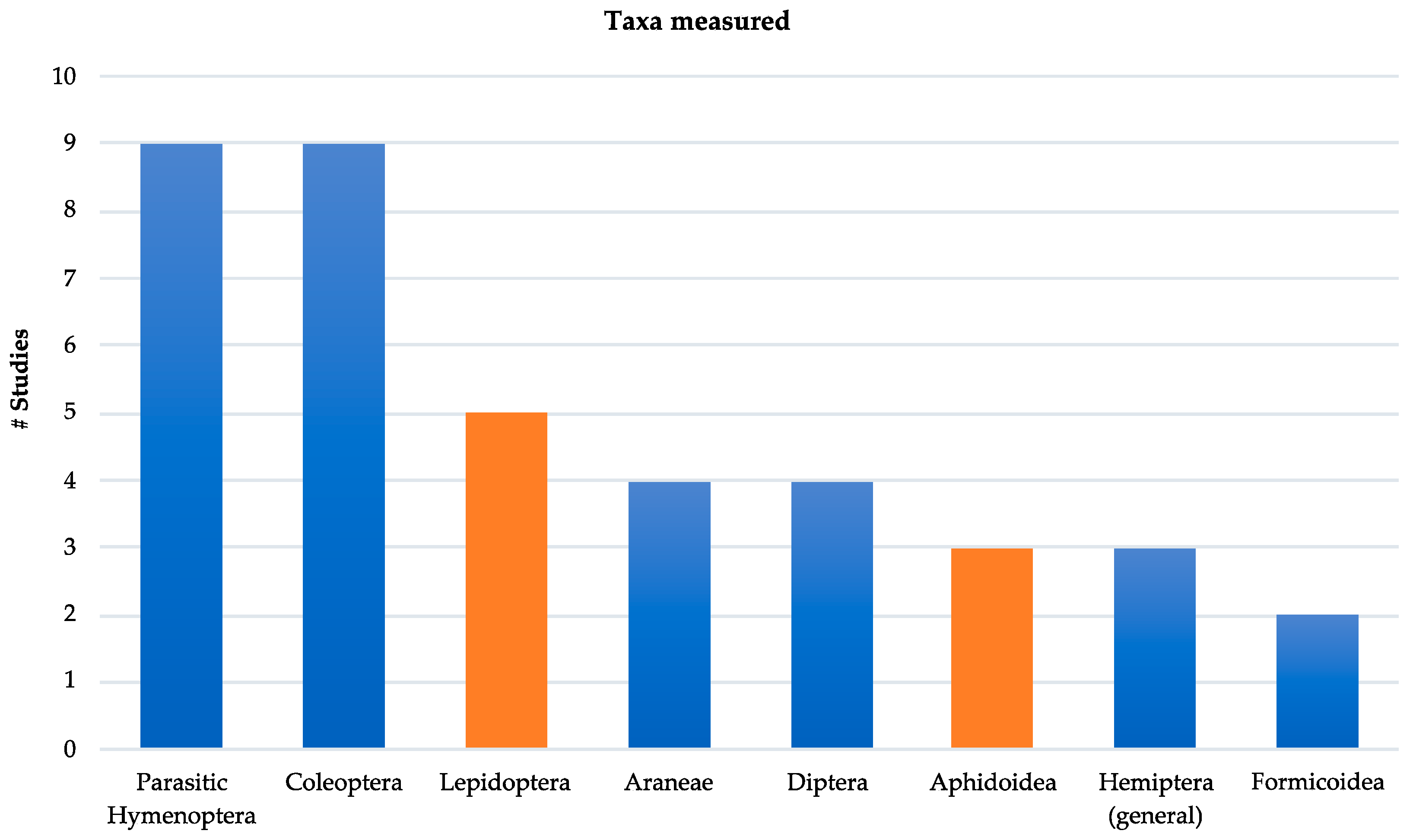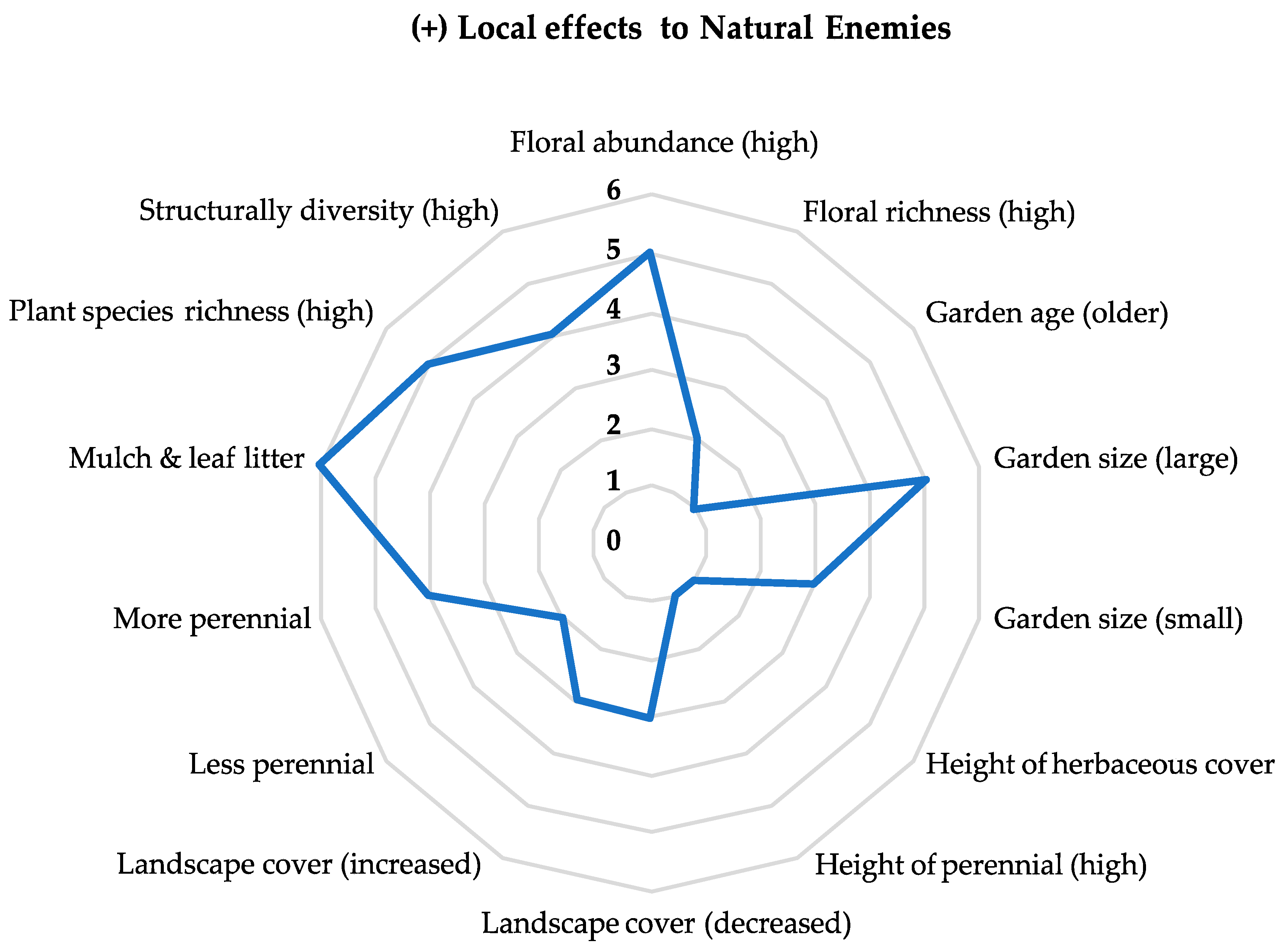Local and Landscape Effects to Biological Controls in Urban Agriculture—A Review
Abstract
:1. Introduction
1.1. Pests, Natural Enemies and Pest Control in Urban Agriculture
1.2. Research and Extension in Context of Urban Agriculture
2. Literature Review Methodology
3. Results
3.1. Effects of Local on-Farm Management on Taxa
3.1.1. Herbivorous Insect Pests
3.1.2. Natural Enemies
3.2. Effects of Surrounding Landscape on Taxa
3.2.1. Herbivore Insect Pests
3.2.2. Natural Enemies
3.3. Local and Landscape Effects on Conservation Biological Control
4. Discussion
5. Conclusions
Supplementary Materials
Author Contributions
Funding
Conflicts of Interest
Abbreviations
| UA | Urban agriculture |
| CBC | Conservation biological control |
References
- Zezza, A.; Tasciotti, L. Urban Agriculture, Poverty, and Food Security: Empirical Evidence from a Sample of Developing Countries. Food Policy 2010, 35, 265–273. [Google Scholar] [CrossRef]
- Mok, H.-F.; Williamson, V.G.; Grove, J.R.; Burry, K.; Barker, S.F.; Hamilton, A.J. Strawberry Fields Forever? Urban Agriculture in Developed Countries: A Review. Agron. Sustain. Dev. 2014, 34, 21–43. [Google Scholar] [CrossRef]
- Lawson, L.J.; Drake, L. Community Gardening Organization Survey; American Community Gardening Association: Columbus, OH, USA, 2012; p. 29. [Google Scholar]
- Clinton, N.; Stuhlmacher, M.; Miles, A.; Uludere Aragon, N.; Wagner, M.; Georgescu, M.; Herwig, C.; Gong, P. A Global Geospatial Ecosystem Services Estimate of Urban Agriculture. Earth’s Future 2018, 6, 40–60. [Google Scholar] [CrossRef]
- Oberholtzer, L.; Dimitri, C.; Pressman, A. Organic agriculture in U.S. urban areas building bridges between organic farms and education. In Proceedings of the Practitioners’ Track, IFOAM Organic World Congress 2014, Istanbul, Turkey, 13–15 October 2014. [Google Scholar]
- Gregory, M.M.; Leslie, T.W.; Drinkwater, L.E. Agroecological and Social Characteristics of New York City Community Gardens: Contributions to Urban Food Security, Ecosystem Services, and Environmental Education. Urban Ecosyst. 2016, 19, 763–794. [Google Scholar] [CrossRef]
- Faeth, S.H.; Bang, C.; Saari, S. Urban Biodiversity: Patterns and Mechanisms: Urban Biodiversity. Ann. N. Y. Acad. Sci. 2011, 1223, 69–81. [Google Scholar] [CrossRef] [PubMed]
- Heimpel, G.E.; Mills, N. Biological Control: Ecology and Applications; Cambridge University Press: Cambridge, UK, 2017. [Google Scholar]
- Dale, A.G.; Frank, S.D. Urban Warming Trumps Natural Enemy Regulation of Herbivorous Pests. Ecol. Appl. 2014, 24, 1596–1607. [Google Scholar] [CrossRef] [PubMed]
- Meineke, E.K.; Dunn, R.R.; Sexton, J.O.; Frank, S.D. Urban Warming Drives Insect Pest Abundance on Street Trees. PloS ONE 2013, 8, e59687. [Google Scholar] [CrossRef]
- Turrini, T.; Sanders, D.; Knop, E. Effects of Urbanization on Direct and Indirect Interactions in a Tri-Trophic System. Ecol. Appl. 2016, 26, 664–675. [Google Scholar] [CrossRef]
- Altieri, M.A.; Companioni, N.; Cañizares, K.; Murphy, C.; Rosset, P.; Bourque, M.; Nicholls, C.I. The Greening of the “Barrios”: Urban Agriculture for Food Security in Cuba. Agric. Hum. Values 1999, 16, 131–140. [Google Scholar] [CrossRef]
- Arnold, J.; Altieri, M.A. An Agroecological Survey of Urban Agriculture in the East Bay of California. In Proceedings of the Organic Agriculture Research Symposium: Proceedings and Recordings, Pacific Grove, CA, USA, 20 January 2016. [Google Scholar]
- Loram, A.; Warren, P.H.; Gaston, K.J. Urban Domestic Gardens (XIV): The Characteristics of Gardens in Five Cities. Environ. Manag. 2008, 42, 361–376. [Google Scholar] [CrossRef]
- Clarke, L.W.; Jenerette, G.D. Biodiversity and Direct Ecosystem Service Regulation in the Community Gardens of Los Angeles, CA. Landsc. Ecol. 2015, 30, 637–653. [Google Scholar] [CrossRef]
- Taylor, J.R.; Lovell, S.T.; Wortman, S.E.; Chan, M. Ecosystem Services and Tradeoffs in the Home Food Gardens of African American, Chinese-Origin and Mexican-Origin Households in Chicago, IL. Renew. Agric. Food Syst. 2016, 1–18. [Google Scholar] [CrossRef]
- Lin, B.B.; Philpott, S.M.; Jha, S. The Future of Urban Agriculture and Biodiversity-Ecosystem Services: Challenges and next Steps. Basic Appl. Ecol. 2015, 16, 189–201. [Google Scholar] [CrossRef]
- Bianchi, F.J.J.A.; Booij, C.J.H.; Tscharntke, T. Sustainable Pest Regulation in Agricultural Landscapes: A Review on Landscape Composition, Biodiversity and Natural Pest Control. Proc. R. Soc. B Biol. Sci. 2006, 273, 1715–1727. [Google Scholar] [CrossRef] [PubMed]
- Chaplin-Kramer, R.; O’Rourke, M.E.; Blitzer, E.J.; Kremen, C. A Meta-Analysis of Crop Pest and Natural Enemy Response to Landscape Complexity: Pest and Natural Enemy Response to Landscape Complexity. Ecol. Lett. 2011, 14, 922–932. [Google Scholar] [CrossRef] [PubMed]
- Letourneau, D.K.; Armbrecht, I.; Rivera, B.S.; Lerma, J.M.; Carmona, E.J.; Daza, M.C.; Escobar, S.; Galindo, V.; Gutiérrez, C.; López, S.D.; et al. Does Plant Diversity Benefit Agroecosystems? A Synthetic Review. Ecol. Appl. 2011, 21, 9–21. [Google Scholar] [CrossRef]
- Altieri, M.A. The Ecological Role of Biodiversity in Agroecosystems. Agric. Ecosyst. Environ. 1999, 74, 19–31. [Google Scholar] [CrossRef]
- Landis, D.A.; Wratten, S.D.; Gurr, G.M. Habitat Management to Conserve Natural Enemies of Arthropod Pests in Agriculture. Annu. Rev. Entomol. 2000, 45, 175–201. [Google Scholar] [CrossRef]
- Rebek, E.J.; Sadof, C.S.; Hanks, L.M. Influence of Floral Resource Plants on Control of an Armored Scale Pest by the Parasitoid Encarsia citrina (Craw.) (Hymenoptera: Aphelinidae). Biol. Control 2006, 37, 320–328. [Google Scholar] [CrossRef]
- Rusch, A.; Bommarco, R.; Jonsson, M.; Smith, H.G.; Ekbom, B. Flow and Stability of Natural Pest Control Services Depend on Complexity and Crop Rotation at the Landscape Scale. J. Appl. Ecol. 2013, 50, 345–354. [Google Scholar] [CrossRef]
- Crowder, D.W.; Jabbour, R. Relationships between Biodiversity and Biological Control in Agroecosystems: Current Status and Future Challenges. Biol. Control 2014, 75, 8–17. [Google Scholar] [CrossRef]
- Tscharntke, T.; Klein, A.M.; Kruess, A.; Steffan-Dewenter, I.; Thies, C. Landscape Perspectives on Agricultural Intensification and Biodiversity—Ecosystem Service Management. Ecol. Lett. 2005, 8, 857–874. [Google Scholar] [CrossRef]
- Tamburini, G.; De Simone, S.; Sigura, M.; Boscutti, F.; Marini, L. Soil Management Shapes Ecosystem Service Provision and Trade-Offs in Agricultural Landscapes. Proc. R. Soc. B Biol. Sci. 2016, 283, 20161369. [Google Scholar] [CrossRef] [PubMed]
- Philpott, S.M.; Bichier, P. Local and Landscape Drivers of Predation Services in Urban Gardens. Ecol. Appl. 2017, 27, 966–976. [Google Scholar] [CrossRef] [PubMed]
- Pullin, A.S.; Stewart, G.B. Guidelines for Systematic Review in Conservation and Environmental Management. Conserv. Biol. 2006, 20, 1647–1656. [Google Scholar] [CrossRef]
- Egerer, M.H.; Arel, C.; Otoshi, M.D.; Quistberg, R.D.; Bichier, P.; Philpott, S.M. Urban Arthropods Respond Variably to Changes in Landscape Context and Spatial Scale. J. Urban Ecol. 2017, 3. [Google Scholar] [CrossRef]
- Morales, H.; Ferguson, B.; Marín, L.; Gutiérrez, D.; Bichier, P.; Philpott, S. Agroecological Pest Management in the City: Experiences from California and Chiapas. Sustainability 2018, 10, 2068. [Google Scholar] [CrossRef]
- Mace-Hill, K.C. Understanding, Using, and Promoting Biological Control: From Commercial Walnut Orchards to School Gardens. Ph.D. Thesis, University of California Berkeley, Berkeley, CA, USA, 2015. [Google Scholar]
- Burks, J.M.; Philpott, S.M. Local and Landscape Drivers of Parasitoid Abundance, Richness, and Composition in Urban Gardens. Environ. Entomol. 2017, 46, 201–209. [Google Scholar] [CrossRef]
- Egerer, M.H.; Liere, H.; Lin, B.B.; Jha, S.; Bichier, P.; Philpott, S.M. Herbivore Regulation in Urban Agroecosystems: Direct and Indirect Effects. Basic Appl. Ecol. 2018, 29, 44–54. [Google Scholar] [CrossRef]
- Lowenstein, D.M.; Minor, E.S. Herbivores and Natural Enemies of Brassica Crops in Urban Agriculture. Urban Ecosyst. 2018, 21, 519–529. [Google Scholar] [CrossRef]
- Gardiner, M.M.; Prajzner, S.P.; Burkman, C.E.; Albro, S.; Grewal, P.S. Vacant Land Conversion to Community Gardens: Influences on Generalist Arthropod Predators and Biocontrol Services in Urban Greenspaces. Urban Ecosyst. 2014, 17, 101–122. [Google Scholar] [CrossRef]
- Christie, F.J.; Hochuli, D.F. Responses of Wasp Communities to Urbanization: Effects on Community Resilience and Species Diversity. J. Insect Conserv. 2009, 13, 213–221. [Google Scholar] [CrossRef]
- Bennett, A.B.; Gratton, C. Local and Landscape Scale Variables Impact Parasitoid Assemblages across an Urbanization Gradient. Landsc. Urban Plan. 2012, 104, 26–33. [Google Scholar] [CrossRef]
- Egerer, M.; Li, K.; Ong, T. Context Matters: Contrasting Ladybird Beetle Responses to Urban Environments across Two US Regions. Sustainability 2018, 10, 1829. [Google Scholar] [CrossRef]
- McCravy, K. A Review of Sampling and Monitoring Methods for Beneficial Arthropods in Agroecosystems. Insects 2018, 9, 170. [Google Scholar] [CrossRef] [PubMed]
- Doxon, E.D.; Davis, C.A.; Fuhlendorf, S.D. Comparison of Two Methods for Sampling Invertebrates: Vacuum and Sweep-Net Sampling: Methods of Sampling Invertebrates. J. Field Ornithol. 2011, 82, 60–67. [Google Scholar] [CrossRef]
- Egerer, M.H.; Liere, H.; Bichier, P.; Philpott, S.M. Cityscape Quality and Resource Manipulation Affect Natural Enemy Biodiversity in and Fidelity to Urban Agroecosystems. Landsc. Ecol. 2018, 33, 985–998. [Google Scholar] [CrossRef]
- Chisholm, P.J.; Gardiner, M.M.; Moon, E.G.; Crowder, D.W. Tools and Techniques for Investigating Impacts of Habitat Complexity on Biological Control. Biol. Control 2014, 75, 48–57. [Google Scholar] [CrossRef]
- Lagucki, E.; Burdine, J.D.; McCluney, K.E. Urbanization Alters Communities of Flying Arthropods in Parks and Gardens of a Medium-Sized City. PeerJ 2017, 5, e3620. [Google Scholar] [CrossRef]
- Sperling, C.D.; Lortie, C.J. The Importance of Urban Backgardens on Plant and Invertebrate Recruitment: A Field Microcosm Experiment. Urban Ecosyst. 2010, 13, 223–235. [Google Scholar] [CrossRef]
- Qian, Y.; Zhou, W.; Yu, W.; Pickett, S.T.A. Quantifying Spatiotemporal Pattern of Urban Greenspace: New Insights from High Resolution Data. Landsc. Ecol. 2015, 30, 1165–1173. [Google Scholar] [CrossRef]


| Explanatory Variables | Parasitoids | Predators | Herbivorous Taxa | Predation/Parasitism | ||||||||||||
|---|---|---|---|---|---|---|---|---|---|---|---|---|---|---|---|---|
| A+ | R+ | A- | R- | A+ | R+ | A- | R- | A+ | R+ | A- | R- | Pr+ | Pa+ | Pr- | Pa- | |
| Landscape Effects | ||||||||||||||||
| Impervious surface (% high) | 2 | 1 | 1 | 3 | 3 | 2 | 2 | 1 | 1 | 1 | 2 | 1 | ||||
| Impervious surface (% low) | 1 | 3 | 2 | 1 | ||||||||||||
| Proximity to agriculture | 1 | 1 | ||||||||||||||
| TOTAL | 4 | 0 | 1 | 1 | 6 | 5 | 2 | 2 | 0 | 2 | 1 | 1 | 2 | 0 | 2 | 0 |
| Local Effects | ||||||||||||||||
| Garden size (large) | 2 | 1 | 1 | 1 | 1 | |||||||||||
| Garden size (small) | 2 | 1 | 1 | |||||||||||||
| Host density | 1 | 1 | ||||||||||||||
| More perennial | 1 | 2 | 3 | 1 | ||||||||||||
| Less perennial | 1 | 1 | ||||||||||||||
| Height of perennial | 1 | 1 | ||||||||||||||
| Plant species richness (high) | 1 | 1 | 1 | 1 | 2 | 1 | ||||||||||
| Plant species richness (low) | 1 | |||||||||||||||
| Structurally diverse | 11 | 21 | 11 | 1 | ||||||||||||
| Mulch | 2 | 2 | 1 | |||||||||||||
| Leaf litter | 2 | |||||||||||||||
| Landscape cover (increased) | 1 | 1 | 2 | |||||||||||||
| Landscape cover (decreased) | 1 | 1 | 2 | |||||||||||||
| Canopy cover | 1 | 1 | ||||||||||||||
| Floral abundance | 1 | 12 | 3 | 1 | ||||||||||||
| Floral richness | 1 | 12 | ||||||||||||||
| Garden age (older) | 1 | 1 | 1 | |||||||||||||
| Height of herbaceous cover | 1 | |||||||||||||||
| TOTAL | 9 | 6 | 2 | 0 | 1 | 8 | 0 | 1 | 1 | 5 | 3 | 2 | 9 | 0 | 5 | 1 |
© 2019 by the authors. Licensee MDPI, Basel, Switzerland. This article is an open access article distributed under the terms and conditions of the Creative Commons Attribution (CC BY) license (http://creativecommons.org/licenses/by/4.0/).
Share and Cite
Arnold, J.E.; Egerer, M.; Daane, K.M. Local and Landscape Effects to Biological Controls in Urban Agriculture—A Review. Insects 2019, 10, 215. https://doi.org/10.3390/insects10070215
Arnold JE, Egerer M, Daane KM. Local and Landscape Effects to Biological Controls in Urban Agriculture—A Review. Insects. 2019; 10(7):215. https://doi.org/10.3390/insects10070215
Chicago/Turabian StyleArnold, Joshua E., Monika Egerer, and Kent M. Daane. 2019. "Local and Landscape Effects to Biological Controls in Urban Agriculture—A Review" Insects 10, no. 7: 215. https://doi.org/10.3390/insects10070215
APA StyleArnold, J. E., Egerer, M., & Daane, K. M. (2019). Local and Landscape Effects to Biological Controls in Urban Agriculture—A Review. Insects, 10(7), 215. https://doi.org/10.3390/insects10070215





